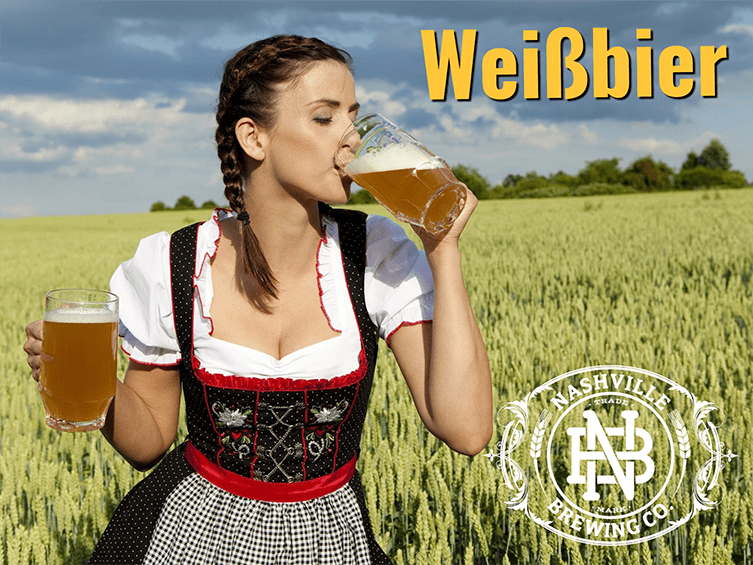
Weißbier and the Wittelsbachs of Bavaria
The Hazy History of Hefeweizens
By Scott R. Mertie
When the Craft Brewers Conference (CBC) was in Nashville in May 2018, members of the Tennessee Craft Brewers Guild collaborated at Blackstone Brewing Company to brew a Maibock for the conference. The beer was named Mockingbird Maibock, after Tennessee’s state bird. I was tasked to write an article for the Brewers Association (BA) about Nashville’s German heritage and highlighting the Maibock style from our city’s past.
Five years later, we are excited to be hosting the CBC in Music City again! This year, Blackstone Brewing Company brewed a hefeweizen using ingredients provided by sponsors, which will be available at the conference. Hefeweizens are the perfect spring beer, so it certainly makes sense to feature this classic “New World” version at the CBC in May!
Since I am a brewing history enthusiast, I thought it appropriate to share the fascinating background of this Bavarian wheat beer. Weißbräu has been brewed for thousands of years but became increasingly popular in Bavaria and Bohemia in the fifteenth Century. These wheat ales were dubbed “white beers”, as they were significantly lighter in color when compared to braunbier (brown ale), the main style of Bavaria 500+ years ago.
But before we go any further, we must first have a brief German language lesson: Weißbräu (weißbier or weissbier) directly translates to “white beer.” Hefeweizen translates to “yeast” (hefe) and “wheat” (weizen) which are unfiltered, hence the haziness. Hefeweizens should not be confused with kristalweizen (clear or filtered wheat) and dunkelweizen (dark wheat) beers.
Weißbiers are light in color because the grain bill is comprised primarily of malted wheat, along with some malted barley. The malt was sun-dried, rather than roasted by fire, which resulted in a much lighter color (this was really the only “light” colored beer in the region until the kilning method was introduced in the mid-1800s). Weißbier was immensely popular, especially among the aristocrats of Bavaria, including the Wittelsbach family.

The Wittelsbachs were the royal family of Bavaria and ruled the region from 1180 through 1918. In fact, it was Ludwig II “the Severe,” the fourth Wittelsbach Duke of Bavaria, who started Munich’s first brewery in 1269.
Jumping forward several centuries, the Wittelsbachs first introduced the Reinheitsgebot, or the Bavarian Purity Law. Duke Wilhelm IV and his brother, Ludwig X, proposed the decree in 1487 and later adopted it throughout Bavaria in 1516.
Most of us are familiar with the Reinheitsgebot and how it limited the ingredients of beer to malted barley, hops, and water (yeast was not yet known to be an ingredient). However, the law was also written to ensure wheat was used for baking (rather than brewing) to help control bread prices.
But how does the classic Bavarian hefeweizen fit into the mix since it is comprised of mostly wheat rather than barley as proclaimed in the Reinheitsgebot? Well, that goes back to the old saying, “do as I say, not as I do.” The Wittelsbachs loved weißbier and in 1520, gave special permission to the Degenberg family to brew weißbier at their brewery in Schwarzach, a small town in Eastern Bavaria near the modern-day Czech border.
The next Duke of Bavaria, Albrecht V, amended the Reinheitsgebot in 1553 by declaring an official brewing season, forbidding brewing from April 23 through September 24. It was known for some time that beer would “turn” during the warmer months (of course we now know that warmer temperatures enhance bacteria growth). Therefore, the last beers brewed in the spring were lagered (stored) in caves/kellers during the summer, which ultimately gave birth to Märzenbier (but that’s another story). However, weißbier was not subject to these brewing restrictions and could be brewed all year long.
By the late 1500s, the Degenbergs were showing significant profits from the weißbier, and the next Wittelsbach heir, Duke Wilhelm V (who is credited for establishing the Hofbräuhaus in 1589), “snubbed” wheat beers, stating that they were “inferior” to the royal beers made in Munich.

In 1602 Hans VIII Sigmund von Degenberg died in 1602 without any heirs and his brewery transferred to Duke Maximilian I, the current Wittelsbach at the helm of Bavaria. Shortly afterwards, the Duke began expanding his weißbier empire throughout Bavaria and ordered it to be available at every bierstube for all social classes to enjoy.
At this point, Maximilian I’s monopoly on weißbier proved to be financially lucrative. The Duke of Bavaria was a devoted Catholic and played a significant role in the Thirty Years War (1618-1648). By the peak of the war, weißbier accounted for 30% of his income and helped fund the conflict against the Protestants.
For the next two hundred years, hefeweizens were enjoyed throughout the Bavarian region. However, by the late 1700s, a new beer style was gaining popularity. These lagers were naturally “clear” because the yeast settled to the bottom of the barrel while stored during the summer. Suddenly, “hazy” hefeweizens were no longer sought after and weißbiers started to fade away.
By the mid-1800s, the pale Pilsner style had taken over and hefeweizens were all but extinct. To make room for more lagerbier in their empire, the Wittelsbachs sold the rights to produce weißbier in 1856 to George Schneider. The Schneider family maintained the hefeweizen tradition and continues to brew their popular Schneider Weisse to this day.
Hefeweizens started making a comeback in the late 20th century and now we see plenty of varieties of this popular weißbier throughout the world. Without the House of Wittelsbach and their extensive line of “brewing royalty,” we would not have the wonderful weißbier we know and love to drink today. NBC Weißbier will be available at the Craft Brewers Conference, as well as the brewery’s taproom.
Incidentally, we celebrate the Wittelsbach family every year in late September. In 1810 Crown Prince Ludwig I, the son of King Maximillian I Joseph of Bavaria, was to marry Therese of Saxony-Hildurghausen. The King invited all of Munich to attend the wedding celebration and provided them with free beer. To show their gratitude, the people of Munich gathered annually at the wiesn (meadow) to celebrate the royal wedding of the Wittelsbachs. Today millions of people celebrate the Wittelsbach wedding at this same location - we call it Oktoberfest. Prost!
Scott R. Mertie
Owner, Nashville Brewing Company
(1859 – 1890; 2016 – present)
Member, Brewers Association
